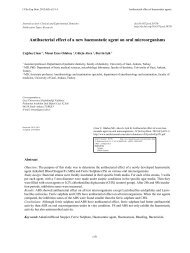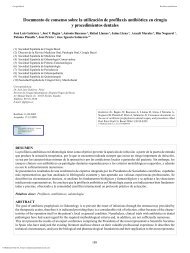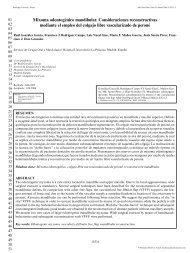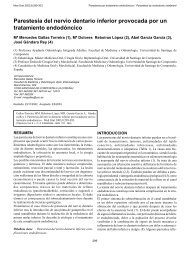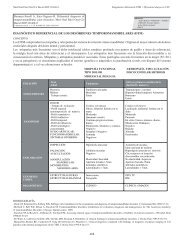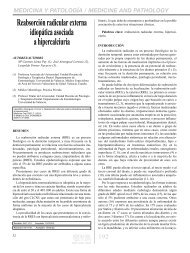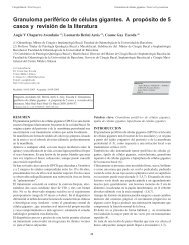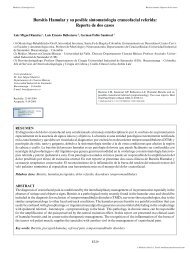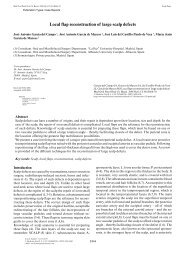Hiperplasia fibrosa asociada a prótesis con áreas simulando un ...
Hiperplasia fibrosa asociada a prótesis con áreas simulando un ...
Hiperplasia fibrosa asociada a prótesis con áreas simulando un ...
You also want an ePaper? Increase the reach of your titles
YUMPU automatically turns print PDFs into web optimized ePapers that Google loves.
Medicina y Patología Oral / Oral Medicine and Pathology <strong>Hiperplasia</strong> <strong>fibrosa</strong> / Denture hyperplasia<br />
<strong>Hiperplasia</strong> <strong>fibrosa</strong> <strong>asociada</strong> a <strong>prótesis</strong> <strong>con</strong> <strong>áreas</strong> <strong>simulando</strong> <strong>un</strong> papiloma oral ductal<br />
invertido<br />
Denture hyperplasia with areas simulating oral inverted ductal papilloma<br />
Pablo Agustin Vargas, Danyel Elias da Cruz Perez, Jacks Jorge, Ana Lúcia Carrinho Ayrosa Rangel, Jorge Esquiche<br />
León, Oslei Paes de Almeida<br />
División de Patología Oral, Facultad de Odontología de Piracicaba – UNICAMP, Piracicaba, São Paulo, Brasil<br />
Correspondencia / Address:<br />
Pablo Agustin Vargas, DDS, PhD<br />
División de Patología Oral, Facultad de Odontología de Piracicaba/ UNICAMP<br />
Caja postal 52 - CEP 13414-903<br />
Piracicaba, São Paulo, Brasil<br />
Tel.: +55-19-3412-5319<br />
Fax: +55-19-3412-5218<br />
E-mail: pavargas@fop.<strong>un</strong>icamp.br<br />
Recibido / Received: 14-03-2004 Aceptado / Accepted: 12-08-2004<br />
RESUMEN<br />
La hiperplasia <strong>fibrosa</strong> <strong>asociada</strong> a <strong>prótesis</strong> es <strong>un</strong>a lesión reactiva<br />
de la mucosa oral, generalmente <strong>asociada</strong> a <strong>prótesis</strong> mal adaptadas.<br />
Son fácilmente diagnosticadas y en alg<strong>un</strong>os casos pueden<br />
en<strong>con</strong>trarse variantes microscópicas distintas como es metaplasia<br />
ósea, oncocítica y escamosa. Estas alteraciones metaplásicas<br />
probablemente están relacionadas <strong>con</strong> el infiltrado linfocítico<br />
usualmente presente en estas lesiones. En este trabajo se reporta<br />
<strong>un</strong> caso de hiperplasia <strong>fibrosa</strong> <strong>asociada</strong> a <strong>prótesis</strong> <strong>con</strong>teniendo<br />
tejido glandular salival <strong>con</strong> alteraciones ductales imitando <strong>un</strong><br />
papiloma oral ductal invertido.<br />
Palabras clave: <strong>Hiperplasia</strong> <strong>fibrosa</strong> <strong>asociada</strong> a <strong>prótesis</strong>, metaplasia<br />
escamosa, papiloma oral ductal invertido.<br />
INTRODUCCION<br />
<strong>Hiperplasia</strong> <strong>fibrosa</strong> <strong>asociada</strong> a <strong>prótesis</strong>, también llamada hiperplasia<br />
<strong>fibrosa</strong> inflamatoria, hiperplasia <strong>fibrosa</strong> inducida por<br />
<strong>prótesis</strong> y épulis fisurado, es la lesión más común de la cavidad<br />
oral (1). Es causada por el trauma crónico producido por <strong>prótesis</strong><br />
mal adaptadas, involucrando com<strong>un</strong>mente la mucosa vestibular,<br />
donde los bordes de la dentadura entran en <strong>con</strong>tacto <strong>con</strong> el tejido<br />
adyacente. Se caracteriza por <strong>un</strong>a sobreproducción de tejido<br />
<strong>con</strong>j<strong>un</strong>tivo fibroso, delimitado por epitelio escamoso superficial<br />
e infiltrado en varios grados por células inflamatorias crónicas.<br />
Puede presentar metaplasia ósea, oncocítica y escamosa (2). La<br />
metaplasia oncocítica presente en la hiperplasia <strong>fibrosa</strong> <strong>asociada</strong><br />
a <strong>prótesis</strong> puede estar relacionada <strong>con</strong> efectos linfocíticos sobre<br />
las células de los <strong>con</strong>ductos salivales (2). Recientemente, durante<br />
nuestro examen histopatológico de rutina, fué observado <strong>un</strong><br />
caso de hiperplasia <strong>fibrosa</strong> <strong>asociada</strong> a <strong>prótesis</strong>, la cual interesantemente<br />
presentaba <strong>áreas</strong> <strong>simulando</strong> <strong>un</strong> papiloma oral ductal<br />
Vargas PA, Perez DEC, Jorge J, Rangel ALCA, Léon JE, Almeida<br />
OE. Denture hyperplasia with areas simulating oral inverted ductal papilloma.<br />
Med Oral Patol Oral Cir Bucal 2005;10 Suppl2:E117-21.<br />
© Medicina Oral S. L. C.I.F. B 96689336 - ISSN 1698-4447<br />
E117<br />
Indexed in:<br />
-Index Medicus / MEDLINE / PubMed<br />
-EMBASE, Excerpta Medica<br />
-Indice Médico Español<br />
-IBECS<br />
SUMMARY<br />
Denture hyperplasia is a reactive lesion of the oral mucosa,<br />
usually associated to an ill-fitting denture. This lesion is easily<br />
diagnosed and in some cases distinct microscopic variations such<br />
as osseous, oncocytic and squamous metaplasia may be fo<strong>un</strong>d.<br />
These metaplastic alterations probably are associated with the<br />
lymphocytic infiltrate usually present in denture hyperplasia.<br />
We present a case of denture hyperplasia <strong>con</strong>taining salivary<br />
gland tissue with ductal alterations mimicking an oral inverted<br />
ductal papilloma.<br />
Key words: Denture hyperplasia, squamous metaplasia, oral<br />
inverted ductal papilloma.<br />
INTRODUCTION<br />
Denture hyperplasia, also called fibrous inflammatory hyperplasia,<br />
denture-induced fibrous hyperplasia and epulis fissuratum,<br />
is the most common lesion of the oral cavity (1). It is caused by<br />
chronic trauma produced by ill-fitting denture, most commonly<br />
involving the vestibular mucosa, where denture edges <strong>con</strong>tact the<br />
adjacent tissue. It is characterized by overproduction of fibrous<br />
<strong>con</strong>nective tissue, lined by superficial squamous epithelium and<br />
infiltrated by chronic inflammatory cells in various degrees.<br />
Osseous, oncocytic and squamous metaplasia can be fo<strong>un</strong>d (2).<br />
Oncocytic metaplasia associated with denture hyperplasia can be<br />
related to lymphocytic effects on ductal salivary cells (2).<br />
Recently, during our histopathological routine, a case of denture<br />
hyperplasia that presented interesting areas simulating an oral<br />
inverted ductal papilloma was observed. Therefore, the aim<br />
of this report is to describe these alterations and to discuss its<br />
probable origin.
Med Oral Patol Oral Cir Bucal 2005;10 Suppl2:E117-21. <strong>Hiperplasia</strong> <strong>fibrosa</strong> / Denture hyperplasia<br />
invertido. Así, el objetivo del presente reporte es describir estas<br />
alteraciones y discutir el origen probable.<br />
CASO CLINICO<br />
Una mujer de 69 años de edad se presentó en la Clínica de<br />
Diagnóstico Oral (Orocentro), Facultad de Odontología, Universidad<br />
Estatal de Campinas, Piracicaba, São Paulo, Brasil,<br />
quejándose de <strong>un</strong> nódulo doloroso <strong>con</strong> 10 años de evolución<br />
localizado en el piso anterior de la boca adyacente al proceso<br />
alveolar. La paciente era desdentada y usaba <strong>un</strong>a <strong>prótesis</strong> total<br />
inferior. Clinicamente, la lesión era <strong>un</strong> nódulo blando, parcialmente<br />
ulcerado, bien circ<strong>un</strong>scrito, midiendo 2 cm en su mayor<br />
diámetro. El diagnóstico clínico fue de hiperplasia <strong>fibrosa</strong> <strong>asociada</strong><br />
a <strong>prótesis</strong>, siendo ésta completamente removida y enviada<br />
para análisis histopatológico.<br />
Microscopicamente, estaba compuesta predominantentemente<br />
por tejido <strong>con</strong>j<strong>un</strong>tivo denso <strong>con</strong> tres <strong>áreas</strong> mostrando proyecciones<br />
papilomatosas, las cuales ocupaban la luz de los <strong>con</strong>ductos<br />
excretores de las glándulas salivales menores involucradas (figura<br />
1). Estas <strong>áreas</strong> estaban <strong>con</strong>stituidas por células basaloides,<br />
mezcladas <strong>con</strong> escasas células mucosecretoras, columnares y<br />
cuboidales, rodeadas por <strong>un</strong> infiltrado linfocítico (figura 2). Dos<br />
de las tres <strong>áreas</strong> estaban separados del tejido epitelial superficial<br />
por <strong>un</strong> estroma de tejido <strong>con</strong>j<strong>un</strong>tivo fibroso rodeado por<br />
<strong>un</strong> discreto infiltrado inflamatorio y el área restante mostraba<br />
<strong>con</strong>tinuidad <strong>con</strong> el epitelio de la mucosa. El tejido <strong>con</strong>j<strong>un</strong>tivo<br />
afectado mostró <strong>áreas</strong> de metaplasia escamosa ductal y oncocítica<br />
y sialadenitis crónica inespecífica. No habia evidencias de<br />
atípias celulares. Realizamos <strong>un</strong> estudio inm<strong>un</strong>ohistoquímico<br />
para citoqueratina 7 (clon OV-TL 12/30, Dako A/S, Denmark,<br />
dilución 1:400) y citoqueratina 14 (clon LL002, Novocastra,<br />
dilución 1:200) usando la técnica del complejo avidina-biotina<br />
(ABC). La inm<strong>un</strong>oreactividad para citoqueratina 7 fue predominante<br />
en las células luminales del tejido glandular hiperplásico<br />
(figura 3), mientras que para citoqueratina 14 fue expresada en<br />
células basales (figura 4). Basados en las caraterísticas clínicas y<br />
microscópicas, diagnosticamos a la lesión como <strong>un</strong>a hiperplasia<br />
<strong>fibrosa</strong> inflamatoria <strong>con</strong> <strong>áreas</strong> <strong>simulando</strong> <strong>un</strong> papiloma oral ductal<br />
invertido. Después de <strong>un</strong> año de seguimiento, no se ha detectado<br />
ning<strong>un</strong>a recurrencia.<br />
Fig. 1. Vista microscópica de la hiperplasia<br />
<strong>fibrosa</strong> inflamatoria mostrando proyecciones<br />
papilomatosas las cuales llenan la luz del<br />
<strong>con</strong>ducto excretor de la glándula salival menor,<br />
rodeado por infiltrado linfocítico (H&E, ampliación<br />
original x50).<br />
Microscopical panoramic view of inflammatory<br />
fibrous hyperplasia showing papillomatous projections<br />
filling the lumen of excretory salivary<br />
duct of minor salivary gland, surro<strong>un</strong>ded by<br />
lymphocytic infiltrate (H&E, original magnification<br />
x50).<br />
E118<br />
CASE REPORT<br />
A 69-year-old female presented to the Oral Diagnosis Clinic<br />
(Orocentro), School of Dentistry, State University of Campinas,<br />
Piracicaba, São Paulo, Brazil, complaining of a painful nodule<br />
located in the anterior floor of the mouth adjacent to alveolar<br />
ridge, with 10 years of history. The patient was edentulous and<br />
used a lower total prosthesis. Clinically, the lesion was a tender<br />
nodule, partially ulcerated, well circumscribed and 2.0 cm in<br />
the maximum dimension. The clinical diagnosis was denture<br />
hyperplasia, and the lesion was completely excised and referred<br />
to histopathological analysis.<br />
Microscopically, it was composed predominantly by dense <strong>con</strong>nective<br />
tissue with three areas showing papillomatous projections<br />
filling the lumen of excretory salivary ducts of minor salivary<br />
glands (Figure 1). These areas were <strong>con</strong>stituted by basaloid cells<br />
with scattered mucous, columnar and cuboidal cells surro<strong>un</strong>ded<br />
by lymphocytic infiltrate (Figure 2). Two out of the three areas<br />
were separated from the superficial squamous epithelium by<br />
stromal fibrous <strong>con</strong>nective tissue surro<strong>un</strong>ded by mild chronic inflammatory<br />
infiltrate, and one area was <strong>con</strong>tinuous with the mucosal<br />
epithelium. The <strong>con</strong>nective tissue showed ductal squamous<br />
and oncocytic metaplasia and non-specific chronic sialadenitis.<br />
There were no evidences of cytological atypia. We performed<br />
an imm<strong>un</strong>ohistochemical study for cytokeratin 7 (OV-TL 12/30<br />
clone, Dako A/S, Denmark, dilution 1:400) and cytokeratin 14<br />
(LL002 clone, Novocastra, dilution 1:200) using the avidin-biotin<br />
complex (ABC) technique. Imm<strong>un</strong>oreactivity for CK 7 was<br />
predominantly in the luminal cells of the hyperplastic glandular<br />
tissue (Figure 3), while CK 14 was expressed in the basal cells<br />
(Figure 4). Based on clinical and microscopical features we<br />
diagnosed the lesion as an inflammatory fibrous hyperplasia<br />
with areas simulating oral inverted ductal papilloma. After one<br />
year of follow-up, no recurrence has been detected.
Medicina y Patología Oral / Oral Medicine and Pathology <strong>Hiperplasia</strong> <strong>fibrosa</strong> / Denture hyperplasia<br />
Fig. 2. Área <strong>simulando</strong> <strong>un</strong> papiloma oral ductal invertido, compuesto por células<br />
basaloides en la periferia, células mucosas dispersas y revestidas por células<br />
columnares y cuboidales (PAS, ampliación original x100).<br />
Area simulating oral inverted ductal papilloma, composed by basaloid cells in<br />
the periphery, scattered mucous cells and a lining of columnar and cuboidal<br />
cells (PAS, original magnification x100).<br />
DISCUSION<br />
Los papilomas ductales son tumores muy raros de glándulas<br />
salivales menores de la cavidad oral, los cuales incluyen papiloma<br />
ductal invertido, sialoadenoma papilífero y papiloma<br />
intraductal (3,4). Los papilomas nasales están asociados <strong>con</strong><br />
E119<br />
Fig. 3. Examen inm<strong>un</strong>ohistoquímico de las proyecciones papilomatosas mostrando<br />
fuerte inm<strong>un</strong>orreactividad para citoqueratina 7 en las células luminales<br />
(ampliación original x200).<br />
Imm<strong>un</strong>ohistochemistry of papillomatous projections showing strong imm<strong>un</strong>oreactivity<br />
for Ck 7 in the luminal cells (Original magnification x200).<br />
Fig. 4. Similar a la figura 3, mostrando células basales y no luminales, las cuales presentan<br />
fuerte inm<strong>un</strong>opositividad para citoqueratina 14 (ampliación original x400).<br />
Similar to figure 3, showing basal and non-luminal cells presenting strong imm<strong>un</strong>opositivity<br />
for Ck 14 (Original magnification x400).<br />
DISCUSSION<br />
Ductal papillomas are very rare tumors of the oral minor salivary<br />
glands, that include inverted ductal papilloma, sialadenoma<br />
papilliferum and intraductal papilloma (3,4). The nasal papillomas<br />
are associated with malignant changes, while oral ductal
Med Oral Patol Oral Cir Bucal 2005;10 Suppl2:E117-21. <strong>Hiperplasia</strong> <strong>fibrosa</strong> / Denture hyperplasia<br />
cambios malignos, mientras que los papilomas orales ductales<br />
presentan <strong>un</strong> curso enteramente benigno (3). Hasta la fecha, 33<br />
casos de papilomas orales ductales invertidos han sido publicados<br />
en la literatura inglesa (5). Los sitios más afectados fueron:<br />
labio (15 casos), mucosa bucal/mandibular (13 casos), paladar (3<br />
casos), piso de boca (1 caso) y mucosa oral (1 caso). El rango de<br />
edad de los pacientes afectados varia de 28 a 77 años, habiendo<br />
predominio por el sexo masculino (2.2: 1) (4). El tiempo de<br />
evolución es variable y va desde varios meses hasta 29 años.<br />
Clinicamente, todas las lesiones se presentan como <strong>un</strong> nódulo<br />
submucoso (0.5-1.5 cm), <strong>con</strong> o sin <strong>un</strong>a depresión central. Todos<br />
los papilomas orales ductales invertidos han sido tratados por<br />
excisión quirúrgica completa y no se ha detectado recurrencia<br />
alg<strong>un</strong>a (3-12).<br />
Según estudios inm<strong>un</strong>ohistoquímicos y ultraestructurales, los<br />
papilomas orales ductales invertidos probablemente se originen<br />
de la transición entre la porción proximal del ducto excretorio<br />
de la glándula salivar menor y el epitelio de revestimiento de<br />
la mucosa, donde ocurre diferenciación escamosa (4,9). En<br />
glándulas salivales normales, la positividad para citoqueratina<br />
14 es observada en las células basales de los ductos excretorios<br />
(10,13), como se encuentra en las células basales del papiloma<br />
oral ductal invertido (10). Por otro lado, células luminales normales<br />
presentan ab<strong>un</strong>dante expresión de citoqueratina 7 (13),<br />
mientras que dicha citoqueratina en el papiloma ductal invertido<br />
es ligeramente expresada. En nuestro caso observamos <strong>un</strong>a<br />
fuerte expresión para citoqueratina 7 y 14 en células luminales<br />
y basales, respectivamente. Parece ser que las células mucosas,<br />
escamosas y columnares del papiloma oral ductal invertido se<br />
originan a partir de células basales de los <strong>con</strong>ductos excretores<br />
(4). En nuestro caso, había también células mucosas, escamosas<br />
y columnares además de células cuboidales mostrando proliferación<br />
intraductal.<br />
La etiopatogénesis del papiloma oral ductal invertido permanece<br />
des<strong>con</strong>ocida. Mediante estudios de hibridización in situ<br />
y reacción en cadena de la polimerasa (PCR) fué reportada<br />
ausencia de DNA del virus papilomavirus humano (4). En <strong>un</strong><br />
caso el paciente fumaba y bebía en exceso (3). En el presente<br />
caso el trauma crónico causó la hiperplasia <strong>fibrosa</strong> inflamatoria<br />
y también estimuló el desarrollo de <strong>áreas</strong> similares a papiloma<br />
ductal linvertido. Nosotros presumimos que la presente lesión<br />
se desarrolló a partir de <strong>un</strong>a metaplasia escamosa ductal que<br />
puede ser en<strong>con</strong>trada en la hiperplasia <strong>fibrosa</strong> inflamatoria (2).<br />
Si la lesión permanece por mucho tiempo, probablemente los<br />
tejidos glandulares hiperplásicos papilares se <strong>un</strong>an formando <strong>un</strong><br />
verdadero papiloma oral ductal invertido, abriendo <strong>un</strong>a nueva<br />
perspectiva sobre la etiogénesis de éste tumor.<br />
El tratamiento de la hiperplasia <strong>fibrosa</strong> <strong>asociada</strong> a <strong>prótesis</strong> es la<br />
excisión quirúrgica y sustitución de la <strong>prótesis</strong>. Es importante<br />
el estudio histopatológico de todos los especímenes quirúrgicos<br />
para <strong>con</strong>firmar el diagnóstico clínico y como en el presente caso,<br />
los patólogos puedan re<strong>con</strong>ocer variaciones histopatológicas<br />
interesantes en <strong>un</strong>a lesión oral común.<br />
E120<br />
papillomas present a full benign course (3). To date 33 cases<br />
of oral inverted ductal papillomas have been published in the<br />
English-language literature (5). Oral sites affected by inverted<br />
ductal papillomas in these 33 cases were the lip (15 cases), buccal<br />
mucosa/mandibular vestibule (13 cases), palate (3 cases), floor<br />
of the mouth (1 case), and the oral mucosa (1 case). Patients<br />
were aged between 28 and 77 years, with a male-to-female<br />
(2.2:1) predominance (4). Clinical duration of the lesion varies<br />
from several months to 29 years. Clinically, all lesions present<br />
as a submucosal nodule (0.5-1.5 cm), with or without a central<br />
p<strong>un</strong>ctum. All oral inverted ductal papillomas have been treated<br />
by complete surgical excision and no recurrences have been<br />
detected (3-12).<br />
According to imm<strong>un</strong>ohistochemical and ultrastructural studies,<br />
oral inverted ductal papillomas probably originate at the j<strong>un</strong>ction<br />
of the proximal portion of the minor salivary gland excretory<br />
duct and the surface mucosal epithelium, where squamous differentiation<br />
occurs (4,9). In normal salivary gland, CK 14 is<br />
observed in basal cells of excretory ducts (10,13), as it is fo<strong>un</strong>d<br />
in basal cells of oral inverted ductal papilloma (10). On the other<br />
hand, normal luminal cells present ab<strong>un</strong>dant expression of CK<br />
7 (13), while in oral inverted ductal papilloma CK 7 is lightly<br />
expressed. We observed in our case, strong expressions of CKs<br />
7 and 14 in luminal and basal cells, respectively. Moreover,<br />
mucous, squamous and columnar cells of the oral inverted ductal<br />
papilloma seem to originate of basal cells of excretory ducts (4).<br />
In our case, there were also mucous, squamous and columnar<br />
cells, besides cuboidal cells showing intraductal proliferation.<br />
The etiopathogenesis of oral inverted ductal papillomas remain<br />
<strong>un</strong>known. Absence of human papillomavirus DNA was reported<br />
by in situ hybridisation and polimerase chain reaction techniques<br />
(4). In one case the patient was a heavy smoker and drinker (3).<br />
In the present case the chronic trauma caused the inflammatory<br />
fibrous hyperplasia, and also stimulated the development of areas<br />
similar to inverted ductal papilloma. We hypothesized that the<br />
present lesion developed from ductal squamous metaplasia<br />
that can be fo<strong>un</strong>d in inflammatory fibrous hyperplasia (2). If<br />
the lesion remained for a long time, the papillary hyperplastic<br />
glandular tissues probably were to join, forming a true oral<br />
inverted ductal papilloma, opening a new perspective about<br />
ethiogenesis of this tumor.<br />
Treatment of denture hyperplasia is surgical excision with<br />
substitution of the denture. It is important to direct all surgical<br />
specimens for histopathological studies to <strong>con</strong>firm or not the<br />
clinical diagnosis, and as in the present case the pathologists can<br />
recognize interesting histopathological variations in a common<br />
oral lesion.
Medicina y Patología Oral / Oral Medicine and Pathology <strong>Hiperplasia</strong> <strong>fibrosa</strong> / Denture hyperplasia<br />
BIBLIOGRAFIA/REFERENCES<br />
1. Williams HK, Hey AA, Browne RM. The use by general dental practitioners<br />
of an oral pathology diagnostic service over a 20-year period: the Birmingham<br />
Dental Hospital experience. Br Dent J 1997;182:424-9.<br />
2. Rangel ALCA, Jorge JJ, Vargas PA. Oncocytic metaplasia in denture hyperplasia.<br />
Is it a rare occurrence? Oral Dis 2002; 8:227-8.<br />
3. Hegarty DJ, Hopper C, Speight PM. Inverted ductal papilloma of minor<br />
salivary glands. J Oral Pathol Med 1994;23:334-6.<br />
4. Koutlas IG, Jessur<strong>un</strong> J, Iamaroon A. Imm<strong>un</strong>ohistochemical evaluation and in<br />
situ hybridization in a case of oral inverted ductal papilloma. J Oral Maxillofac<br />
Surg 1994;52:503-6.<br />
5. Brannon RB, Sciubba JJ, Giuliani M. Ductal papillomas of salivary gland<br />
origin: a report of 19 cases and a review of the literature. Oral Surg Oral Med<br />
Oral Pathol Oral Radiol Endod 2001;92:68-77.<br />
6. Clark DB, Priddy RW, Swanson AE. Oral inverted ductal papilloma. Oral<br />
Surg Oral Med Oral Pathol 1990;69:487-90.<br />
7. Ellis GL, Auclair PL. Ductal papillomas. In: Ellis GL, Auclair PL, Gnepp<br />
DR eds. Surgical pathology of the salivary glands. Philadelphia: WB Sa<strong>un</strong>ders;<br />
1991. p. 238-51.<br />
8. Franklin CD, Ong TK. Ductal papilloma of the minor salivary gland. Histopathology<br />
1991;19: 180-2.<br />
9. Scolyer RA, Rose B, Painter DM. Test and teach. Number 96: Part 1. Inverted<br />
duct papilloma of minor salivary gland origin. Pathology 1999;31:372, 423-4.<br />
10. Sousa SOM, Sesso A, Araujo NS, Araujo VC. Inverted ductal papilloma of<br />
minor salivary gland origin: morphological aspects and cytokeratin expression.<br />
Eur Arch Otorhinolaryngology 1995;252:370-3.<br />
11. White DK, Miller AS, McDaniel RK, Rothman BN. Inverted ductal papilloma.<br />
A distinctive lesion of minor salivary gland. Cancer 1982;49:519-24.<br />
12. Wilson DF, Robinson BW. Oral inverted ductal papilloma. Oral Surg Oral<br />
Med Oral Pathol 1984;57:520-3.<br />
13. Su L, Morgan PR, Harrison DL, Wassem A, Lane EB. Expression of keratin<br />
mRNAs and proteins in normal salivary gland epithelia and pleomorphic<br />
adenomas. J Pathol 1993;17:173-81.<br />
E121




